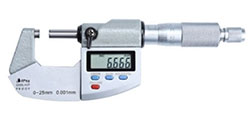Micrometer Selection Guide
A micrometer, also known as an index caliper, is a measuring tool that is mainly used for precision measurements. It is capable of measuring the length, thickness, width, diameter and other dimensions of an object. A micrometer usually consists of a frame, a vernier, a set screw and a moving screw. Micrometers of different sizes have different measuring ranges, accuracies, and prices. So how to choose a micrometer correctly? ATO Store will offer you a series of reference opinions.
Selection Guides for Micrometers
- Choose a specification that suits your needs:
Choose a micrometer specification that suits your needs based on the size of the object as well as the function you need to measure,like digital micrometer or inside micrometer etc. Do not blindly pursue large specifications and ignore actual needs. - Pay attention to accuracy level:
Select a micrometer with the corresponding accuracy level according to the requirements. When high measurement accuracy is required, a micrometer with high accuracy levels such as level 0 or level 1 can be selected. - Material and workmanship:
A micrometer is a precision measuring tool, and the quality of its material and workmanship affects the accuracy and precision of measurement. In general, it is recommended to choose a micrometer made of stainless steels material, as it has high stability and durability. - Brand selection:
Purchasing a micrometer from a reputable brand can ensure product quality and after-sales service. ATO services can meet this requirement if you choose us. - Reasonable price:
Products with too low a price may have quality problems, and those with too high a price may be more than what is actually needed.
In short, the choice of micrometer should be from the measurement range, accuracy level, index value, material and workmanship and other aspects of consideration, choose the right specifications and brands to ensure the precision and accuracy of measurement.
Methods for Maintaining the Micrometers
- The micrometer should be handled with care and should not be touched by hard objects during use. If there is a collision, the interaction between various parts should be checked immediately and the zero position should be calibrated. If any inaccuracies are found, they should be sent to the metrology department for maintenance.
- After using the micrometer, it should be wiped clean with a soft and clean cotton thread, and then placed in a fixed position in its box and stored in a dry place. When stored for a long time, rust preventive oil can be applied to the micrometer screw, and the two measuring surfaces should not come into contact.
- It is not allowed to immerse the micrometer in water, coolant, or oil, nor to inject kerosene, alcohol, engine oil, diesel, or petroleum jelly between the fixed sleeve and differential cylinder of the micrometer. If the micrometer is immersed in the above-mentioned liquids such as water and engine oil, it can be rinsed with aviation gasoline, and then a small amount of lubricating oil can be dropped on the threaded part and other moving parts of the micrometer screw.
- Do not use hard objects such as oil and gauze to grind or dry the measuring surface of the micrometer and the micrometer screw.
- The micrometer should be regularly sent to the metrology department for verification to ensure its accuracy.
Notes for Micrometers
- Reduce the impact of temperature on measurement results.
The technical parameters of the micrometer are calibrated under certain temperature conditions. When using a micrometer for precision measurement, it should be carried out at the same ambient temperature as the calibration micrometer, which can reduce measurement errors caused by temperature differences. When this requirement cannot be met, the tested piece and the micrometer used should be placed under the same conditions for a period of time, and their temperature should be the same before measurement. - It is not allowed to measure the edge of the surface using a micrometer.
Using a micrometer to measure the edge of the surface will not only cause local wear on the measuring surface, but also result in incorrect measurement results. - A micrometer cannot be used to measure rough surfaces.
The surface roughness values of the two measuring surfaces of the micrometer are not greater than Ra0.05μm, so the micrometer is not allowed to measure surfaces with surface roughness greater than Ra0.05μm, which prevents premature wear of the measuring surfaces. - Do not use a micrometer as a caliper.

This incorrect usage not only accelerates the wear of the two measuring surfaces, but also causes deformation of the thread profile of the ruler frame and micrometer screw under the action of QL. - Pay attention to the reading method.
When adjusting the outer diameter micrometer according to the measured size, it is necessary to slowly and steadily rotate the differential cylinder or force measuring device. When touching the measured part, switch to a force measuring device. After hearing 3-5 "clicking" sounds from the force measuring device, gently shake the ruler frame and feel that the two measuring surfaces are in good contact with the measured surface before taking a reading.
Only by following the above procedures and precautions to use the micrometer reasonably can human error be reduced and accurate measurement values be obtained, which can extend the service life of the micrometer.

